Feasibility of Using a Silicon Preparation to Promote Growth of Forest Seedlings: Application to Pine (Pinus sylvestris) and Oak (Quercus robur)
Abstract
:1. Introduction
2. Materials and Methods
2.1. Plant Material and Silicon Preparation
2.2. Testing the Photosynthetic Efficiency
2.3. Measurement of Fresh and Dry Biomass
2.4. Statistical Evaluations
3. Results
3.1. P. sylvestris
3.2. Q. robur
4. Discussion
4.1. Influence of Silicon on Photosynthetic Performance
4.2. Silicon Influence on Pine and Oak Growth Parameters
4.2.1. Effect of Silicone in Leaf Protection against Oak Powdery Mildew
4.2.2. Effect of Silicone on Oak Growth Parameters
4.2.3. Factors That May Affect Silicon Uptake by Above Ground Plant Parts
5. Conclusions
- The silicon preparation has a positive effect on photosynthetic efficiency and, thus, on seedling growth and biomass.
- Even high concentrations of the silicon preparation do not cause phytotoxicity in Scot’s pine needles and English oak leaves.
- The silicon preparation has a positive effect on the needle thickness of pine seedlings.
- Foliar fertilisation with silicon preparations in low concentrations (1–2%) is particularly beneficial, also for economic reasons. The silicon preparation with a concentration of 2% improves photosynthetic efficiency and increases the production of assimilates, which strengthens the seedlings in their first years of life.
- The application of the silicon preparation (spray concentrations of 1% and 2%) reduces the infestation of and damage to oak leaves by powdery mildew (E. alphitoides).
- The duration of the pot trial, one growing season, was too short to fully reveal possible differences between the treatments and the control, especially regarding the effects on root system development.
- In view of the above results, further field trials of at least two to three growing seasons are needed before the preparation can be recommended for silvicultural use on pines and oaks in the first years of their development.
Author Contributions
Funding
Institutional Review Board Statement
Informed Consent Statement
Data Availability Statement
Conflicts of Interest
References
- Datnoff, L.E.; Rodrigues, F.A. Highlights and prospects for using silicon in the future. In Silicon and Plant Diseases; Springer: Berlin/Heidelberg, Germany, 2015; pp. 139–145. [Google Scholar]
- Rodrigues, F.A.; Datnoff, L.E. Silicon and Plant Diseases; Technical Report; Springer: Berlin/Heidelberg, Germany, 2015. [Google Scholar]
- Vasanthi, N.; Saleena, L.M.; Raj, S.A. Silicon in crop production and crop protection-A review. Agric. Rev. 2014, 35, 14–23. [Google Scholar] [CrossRef]
- Sienkiewicz-Cholewa, U.; Zajączkowska, A. The role and yield-forming effect of silicon application based on the example of global research. Prog. Plant Prot. 2020, 60, 313–319. [Google Scholar]
- Van den Driessche, R. Soil fertility in forest nurseries. In Forestry Nursery Manual: Production of Bareroot Seedlings; Springer: Berlin/Heidelberg, Germany, 1984; pp. 63–74. [Google Scholar]
- Bzdyk, R.M.; Olchowik, J.; Studnicki, M.; Oszako, T.; Sikora, K.; Szmidla, H.; Hilszczańska, D. The impact of effective microorganisms (EM) and organic and mineral fertilizers on the growth and mycorrhizal colonization of Fagus sylvatica and Quercus robur seedlings in a bare-root nursery experiment. Forests 2018, 9, 597. [Google Scholar] [CrossRef] [Green Version]
- Mengel, K.; Kirkby, E.A. Principios de Nutrición Vegetal; International Potash Institute: Zug, Switzerland, 2000. [Google Scholar]
- Tubaña, B.S.; Heckman, J.R. Silicon in soils and plants. In Silicon and Plant Disease; Springer: Berlin/Heidelberg, Germany, 2015; pp. 7–51. [Google Scholar]
- Kulikova, A.; Isaichev, V.; Yashin, E.; Saidyasheva, G. The effectiveness of silicon-containing preparations as fertilizers for sugar beet. In E3S Web of Conferences; EDP Sciences: Les Ulis, France, 2020; Volume 224, p. 04041. [Google Scholar]
- Cornelis, J.T.; Delvaux, B.; Cardinal, D.; André, L.; Ranger, J.; Opfergelt, S. Tracing mechanisms controlling the release of dissolved silicon in forest soil solutions using Si isotopes and Ge/Si ratios. Geochim. Cosmochim. Acta 2010, 74, 3913–3924. [Google Scholar] [CrossRef]
- Brucker, E.; Kernchen, S.; Spohn, M. Release of phosphorus and silicon from minerals by soil microorganisms depends on the availability of organic carbon. Soil Biol. Biochem. 2020, 143, 107737. [Google Scholar] [CrossRef]
- Ma, J.F.; Yamaji, N. Silicon uptake and accumulation in higher plants. Trends Plant Sci. 2006, 11, 392–397. [Google Scholar] [CrossRef]
- Mandlik, R.; Thakral, V.; Raturi, G.; Shinde, S.; Nikolić, M.; Tripathi, D.K.; Sonah, H.; Deshmukh, R. Significance of silicon uptake, transport, and deposition in plants. J. Exp. Bot. 2020, 71, 6703–6718. [Google Scholar] [CrossRef] [PubMed]
- Mehrabanjoubani, P.; Abdolzadeh, A.; Sadeghipour, H.R.; Aghdasi, M. Silicon affects transcellular and apoplastic uptake of some nutrients in plants. Pedosphere 2015, 25, 192–201. [Google Scholar] [CrossRef]
- Shivaraj, S.; Mandlik, R.; Bhat, J.A.; Raturi, G.; Elbaum, R.; Alexander, L.; Tripathi, D.K.; Deshmukh, R.; Sonah, H. Outstanding questions on the beneficial role of silicon in crop plants. Plant Cell Physiol. 2022, 63, 4–18. [Google Scholar] [CrossRef] [PubMed]
- Dziadowiec, H. Ekologiczna rola próchnicy glebowej. Zeszyty Problemowe Postępów Nauk Rolniczych 1993, 411, 269–282. [Google Scholar]
- Faquin, V. Nutrição mineral de plantas. In Curso de Pos-Graduacao Sensu Lato (Especializacao) a Distancia: Solos e Meio Ambiente; Universidade Federal de Lavras-UFLA: Lavras, Brazil, 2005. [Google Scholar]
- Pruszyński, S. ączne stosowanie agrochemikaliów. Zagadnienia Doradz. Rol. 2020, 99, 91–106. [Google Scholar]
- Niu, J.; Liu, C.; Huang, M.; Liu, K.; Yan, D. Effects of foliar fertilization: A review of current status and future perspectives. J. Soil Sci. Plant Nutr. 2021, 21, 104–118. [Google Scholar] [CrossRef]
- Sharma, B.; Kumawat, K.C.; Tiwari, S.; Kumar, A.; Dar, R.A.; Singh, U.; Cardinale, M. Silicon and plant nutrition: Dynamics, mechanisms of transport, and role of silicon solubilizer microbiomes in sustainable agriculture. Pedosphere 2022. [Google Scholar] [CrossRef]
- Brunings, A.; Datnoff, L.; Ma, J.; Mitani, N.; Nagamura, Y.; Rathinasabapathi, B.; Kirst, M. Differential gene expression of rice in response to silicon and rice blast fungus Magnaporthe oryzae. Ann. Appl. Biol. 2009, 155, 161–170. [Google Scholar] [CrossRef]
- Shetty, R.; Fretté, X.; Jensen, B.; Shetty, N.P.; Jensen, J.D.; Jørgensen, H.J.L.; Newman, M.A.; Christensen, L.P. Silicon-induced changes in antifungal phenolic acids, flavonoids, and key phenylpropanoid pathway genes during the interaction between miniature roses and the biotrophic pathogen Podosphaera pannosa. Plant Physiol. 2011, 157, 2194–2205. [Google Scholar] [CrossRef] [Green Version]
- Nowakowski, W.; Nowakowska, J. Silicon and copper interaction in the growth of spring wheat seedlings. Biol. Plant. 1997, 39, 463–466. [Google Scholar] [CrossRef]
- Khan, A.; Khan, A.L.; Muneer, S.; Kim, Y.H.; Al-Rawahi, A.; Al-Harrasi, A. Silicon and salinity: Crosstalk in crop-mediated stress tolerance mechanisms. Front. Plant Sci. 2019, 10, 1429. [Google Scholar] [CrossRef] [PubMed] [Green Version]
- Manivannan, A.; Ahn, Y.K. Silicon regulates potential genes involved in major physiological processes in plants to combat stress. Front. Plant Sci. 2017, 8, 1346. [Google Scholar] [CrossRef] [PubMed] [Green Version]
- Souri, Z.; Khanna, K.; Karimi, N.; Ahmad, P. Silicon and plants: Current knowledge and future prospects. J. Plant Growth Regul. 2021, 40, 906–925. [Google Scholar] [CrossRef]
- Wang, S.; Liu, P.; Chen, D.; Yin, L.; Li, H.; Deng, X. Silicon enhanced salt tolerance by improving the root water uptake and decreasing the ion toxicity in cucumber. Front. Plant Sci. 2015, 6, 759. [Google Scholar] [CrossRef] [PubMed] [Green Version]
- Vaculík, M.; Lukačová, Z.; Bokor, B.; Martinka, M.; Tripathi, D.K.; Lux, A. Alleviation mechanisms of metal (loid) stress in plants by silicon: A review. J. Exp. Bot. 2020, 71, 6744–6757. [Google Scholar] [CrossRef] [PubMed]
- Mukarram, M.; Khan, M.A.; Kurjak, D.; Lux, A.; Corpas, F.J. Silicon nanoparticles (SiNPs) restore photosynthesis and essential oil content by upgrading enzymatic antioxidant metabolism in. Front. Plant Sci. 2023, 14, 363. [Google Scholar] [CrossRef]
- Kim, Y.H.; Khan, A.L.; Kim, D.H.; Lee, S.Y.; Kim, K.M.; Waqas, M.; Jung, H.Y.; Shin, J.H.; Kim, J.G.; Lee, I.J. Silicon mitigates heavy metal stress by regulating P-type heavy metal ATPases, Oryza sativalow silicon genes, and endogenous phytohormones. BMC Plant Biol. 2014, 14, 1–13. [Google Scholar] [CrossRef] [Green Version]
- Zhang, X.; Zhang, W.; Lang, D.; Cui, J.; Li, Y. Silicon improves salt tolerance of Glycyrrhiza uralensis Fisch. by ameliorating osmotic and oxidative stresses and improving phytohormonal balance. Environ. Sci. Pollut. Res. 2018, 25, 25916–25932. [Google Scholar] [CrossRef] [PubMed]
- Wang, G.; Liang, Y.H.; Zhang, J.Y.; Cheng, Z.M.M. Cloning, molecular and functional characterization by overexpression in Arabidopsis of MAPKK genes from grapevine (Vitis vinifera). BMC Plant Biol. 2020, 20, 194. [Google Scholar] [CrossRef] [PubMed]
- Wang, G.; Lovato, A.; Liang, Y.; Wang, M.; Chen, F.; Tornielli, G.B.; Polverari, A.; Pezzotti, M.; Cheng, Z. Validation by isolation and expression analyses of the mitogen-activated protein kinase gene family in the grapevine (V itis vinifera L.). Aust. J. Grape Wine Res. 2014, 20, 255–262. [Google Scholar] [CrossRef]
- Kim, Y.H.; Khan, A.L.; Waqas, M.; Lee, I.J. Silicon regulates antioxidant activities of crop plants under abiotic-induced oxidative stress: A review. Front. Plant Sci. 2017, 8, 510. [Google Scholar] [CrossRef] [Green Version]
- SAS/STAT User’s Guide. 2018. Available online: https://support.sas.com/documentation/onlinedoc/stat/indexproc.html (accessed on 10 January 2023).
- Kalaji, H.M.; Bąba, W.; Gediga, K.; Goltsev, V.; Samborska, I.A.; Cetner, M.D.; Dimitrova, S.; Piszcz, U.; Bielecki, K.; Karmowska, K.; et al. Chlorophyll fluorescence as a tool for nutrient status identification in rapeseed plants. Photosynth. Res. 2018, 136, 329–343. [Google Scholar] [CrossRef] [Green Version]
- Rea, R.S.; Islam, M.R.; Rahman, M.M.; Nath, B.; Mix, K. Growth, nutrient accumulation, and drought tolerance in crop plants with silicon application: A review. Sustainability 2022, 14, 4525. [Google Scholar] [CrossRef]
- Rao, B.; Gao, L.; Dai, H.; Hong, Z.; Xie, H. An efficient and sustainable approach for preparing silicon fertilizer by using crystalline silica from ore. JOM 2019, 71, 3915–3922. [Google Scholar] [CrossRef]
- Ali, N.; Réthoré, E.; Yvin, J.C.; Hosseini, S.A. The regulatory role of silicon in mitigating plant nutritional stresses. Plants 2020, 9, 1779. [Google Scholar] [CrossRef]
- Kalaji, M. Oddziaływanie abiotycznych czynników stresowych na fluorescencję chlorofilu w roślinach wybranych odmian jęczmienia Hordeum vulgare L. In Rozprawy Naukowe i Monografie; Szkoła Główna Gospodarstwa Wiejskiego: Warszawa, Poland, 2011; Volume 378. [Google Scholar]
- Krause, G.H.; Weis, E. Chlorophyll fluorescence as a tool in plant physiology: II. Interpretation of fluorescence signals. Photosynth. Res. 1984, 5, 139–157. [Google Scholar] [CrossRef]
- Reynolds, O.L.; Keeping, M.G.; Meyer, J.H. Silicon-augmented resistance of plants to herbivorous insects: A review. Ann. Appl. Biol. 2009, 155, 171–186. [Google Scholar] [CrossRef]
- Ahammed, G.J.; Yang, Y. Mechanisms of silicon-induced fungal disease resistance in plants. Plant Physiol. Biochem. 2021, 165, 200–206. [Google Scholar] [CrossRef] [PubMed]
- Johnson, S.N.; Hartley, S.E.; Ryalls, J.M.; Frew, A.; Hall, C.R. Targeted plant defense: Silicon conserves hormonal defense signaling impacting chewing but not fluid-feeding herbivores. Ecology 2021, 102, e03250. [Google Scholar] [CrossRef] [PubMed]
- Blaich, R.; Grundhöfer, H. Silicate incrusts induced by powdery mildew in cell walls of different plant species/Echter Mehltau induziert Silikateinlagerungen in Zellwänden unterschiedlichster Pflanzenarten. Zeitschrift für Pflanzenkrankheiten und Pflanzenschutz/J. Plant Dis. Prot. 1998, 105, 114–120. [Google Scholar]
- Górecki, R.; Borkowski, J.; Stepowski, J.; Busch-Danielski, W.; Kowalczyk, W. Wplyw krzemu na wzrost i plonowanie oberzyny i pomidora w substracie torfowym. Zeszyty Problemowe Postępów Nauk Rolniczych 2004, 502, 483–489. [Google Scholar]
- Wegorek, W. Współpraca europejskich krajów RWPG w problematyce ochrony roślin. Postępy Nauk Rolniczych 1980, 27, 11–22. [Google Scholar]
- Bent, E.; Loffredo, A.; McKenry, M.; Becker, J.; Borneman, J. Detection and investigation of soil biological activity against Meloidogyne incognita. J. Nematol. 2008, 40, 109. [Google Scholar]
- Luyckx, M.; Hausman, J.F.; Lutts, S.; Guerriero, G. Silicon and plants: Current knowledge and technological perspectives. Front. Plant Sci. 2017, 8, 411. [Google Scholar] [CrossRef] [Green Version]
- Woźniak, M.; Kwaśniewska-Sip, P.; Krueger, M.; Roszyk, E.; Ratajczak, I. Chemical, biological and mechanical characterization of wood treated with propolis extract and silicon compounds. Forests 2020, 11, 907. [Google Scholar] [CrossRef]
- Helaly, M.N.; El-Hoseiny, H.; El-Sheery, N.I.; Rastogi, A.; Kalaji, H.M. Regulation and physiological role of silicon in alleviating drought stress of mango. Plant Physiol. Biochem. 2017, 118, 31–44. [Google Scholar] [CrossRef] [PubMed]
- García-Gaytán, V.; Bojórquez-Quintal, E.; Hernández-Mendoza, F.; Tiwari, D.K.; Corona-Morales, N.; Moradi-Shakoorian, Z. Polymerized silicon (SiO2· nH2O) in equisetum arvense: Potential nanoparticle in crops. J. Chil. Chem. Soc. 2019, 64, 4298–4302. [Google Scholar] [CrossRef] [Green Version]
- Wolff, S.A.; Karoliussen, I.; Rohloff, J.; Strimbeck, R. Foliar applications of silicon fertilisers inhibit powdery mildew development in greenhouse cucumber. J. Food, Agric. Environ. 2012, 10, 355–359. [Google Scholar]
- Jablonski, K. Seniphos w dolistnym nawozeniu ziemniakow. Ziemniak Polski 2001, 2, 28–33. [Google Scholar]
- Michalojc, Z.; Szewczuk, C. Teoretyczne aspekty dolistnego dokarmiania roslin. Acta Agrophys. 2003, 85, 9–17. [Google Scholar]
- Jasinska, Z. Dolistne dokarmianie lucerny mieszańcowej i bobiku. Zeszyty Problemowe Postępów Nauk Rolniczych 1974, 143, 167–174. [Google Scholar]
- Swietlik, D.; Faust, M. Foliar nutrition of fruit crops. Hortic. Rev. (Am. Soc. Hortic. Sci.) 2011, 6, 287–355. [Google Scholar]
- Black, B.L.; Bukovac, M.J.; Hull, J., Jr. Effect of spray volume and time of NAA application on fruit size and cropping of Redchief ‘Delicious’ apple. Sci. Hortic. 1995, 64, 253–264. [Google Scholar] [CrossRef]
- Hull, H.M. Leaf Structure as Related to Absorption of Pesticides and Other Compounds; Springer: Berlin/Heidelberg, Germany, 1970. [Google Scholar]
- Wójcik, P. Pobieranie skladnikow mineralnych przez czesci nadziemne roslin z nawozenia pozakorzeniowego. Postępy Nauk Rolniczych 1998, 45, 49–64. [Google Scholar]
- Alexander, A. Optimum timing of foliar nutrient sprays. Foliar Fertilizaron. Proceedings of First lnternational Symposium on Foliar Fertilization, Berlín; Martinus Nijhoff Publishers: Dordrecht, The Netherlands, 1986; pp. 44–60. [Google Scholar]
- Kannan, S. Foliar fertilization for sustainable crop production. In Genetic Engineering, Biofertilisation, Soil Quality and Organic Farming; Springer: Berlin/Heidelberg, Germany, 2010; pp. 371–402. [Google Scholar]
- Grzys, E. Rola i znaczenie mikroelementow w zywieniu roslin. Zeszyty Problemowe Postępów Nauk Rolniczych 2004, 502, 89–99. [Google Scholar]

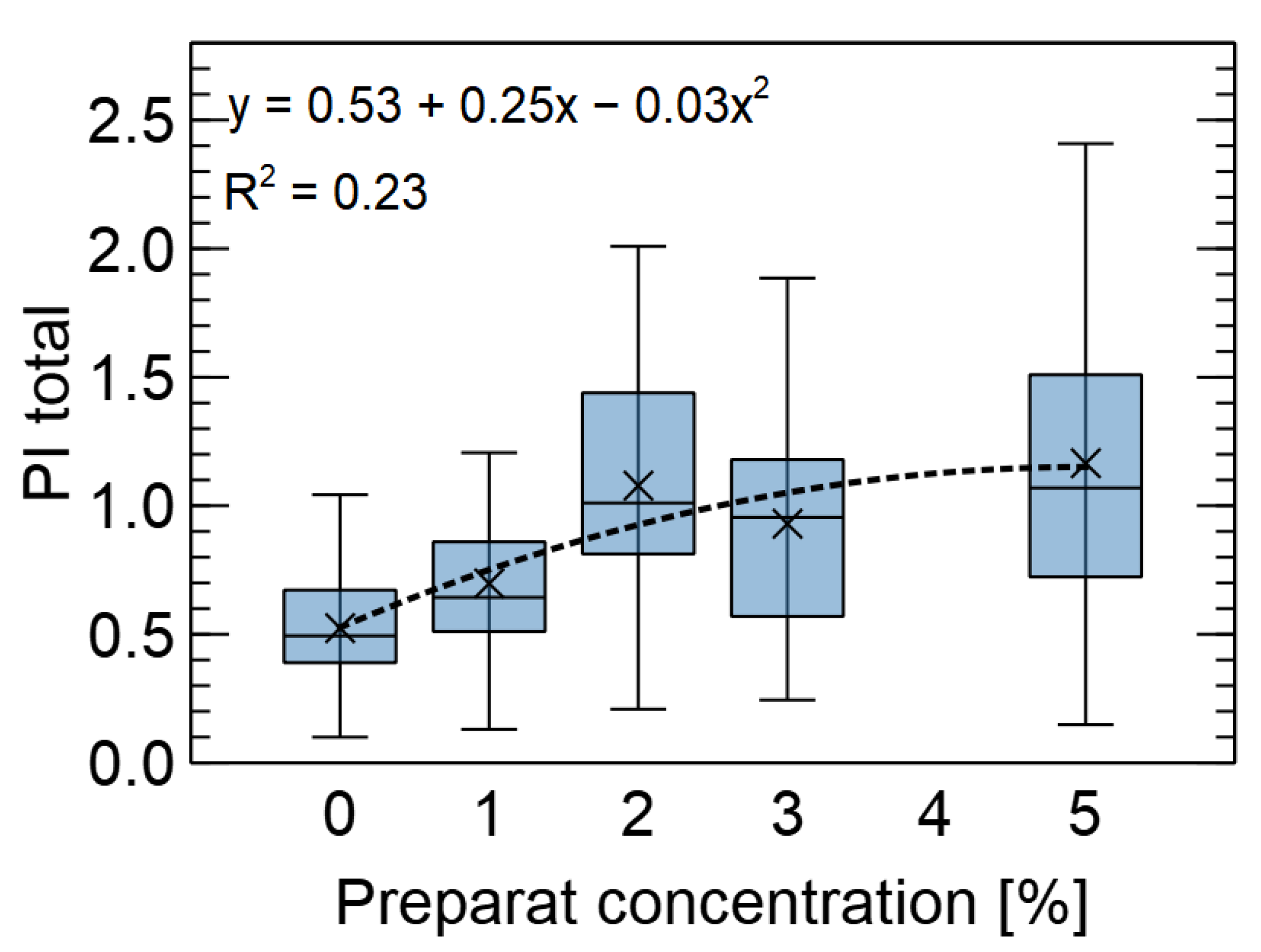

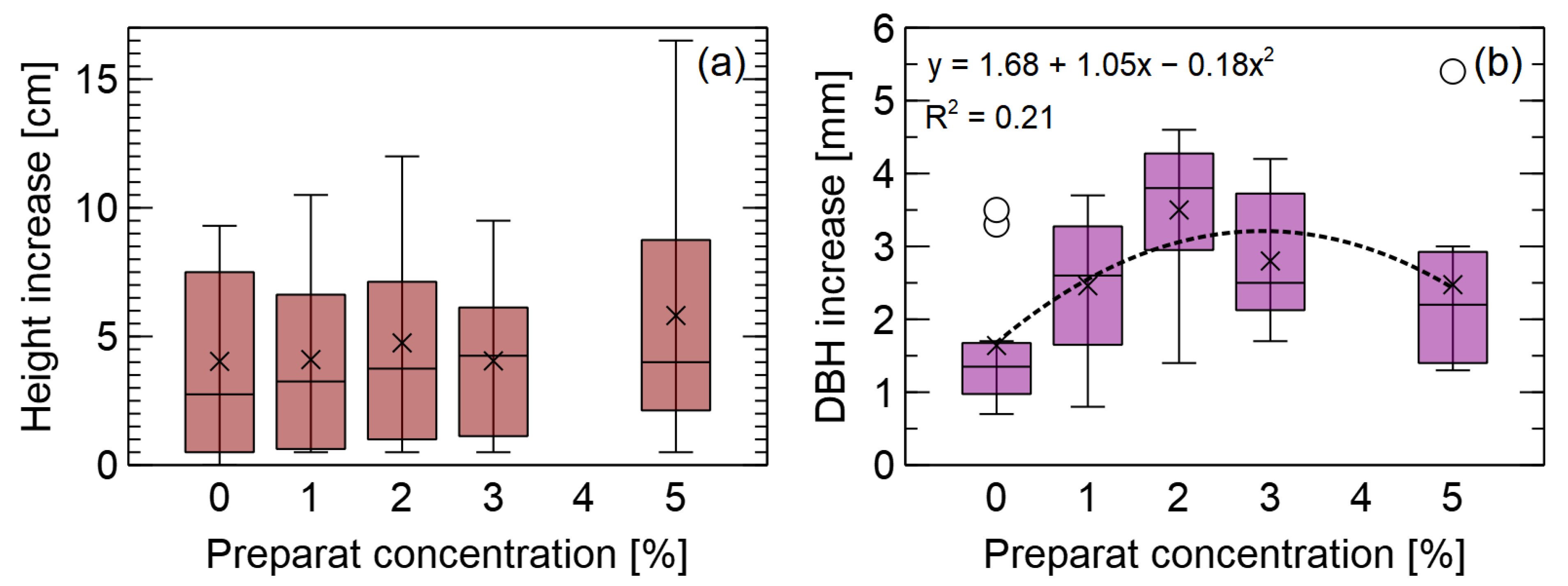

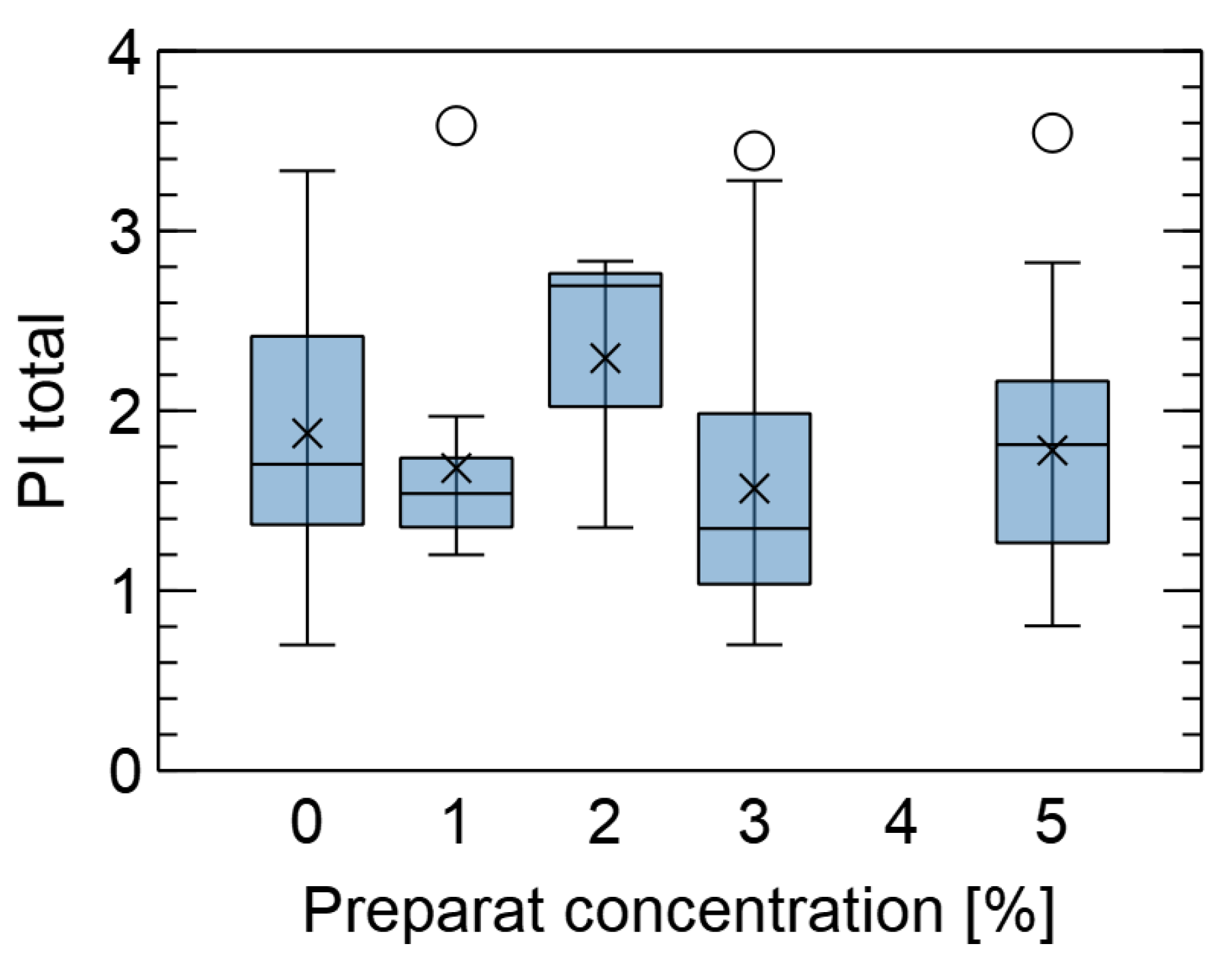
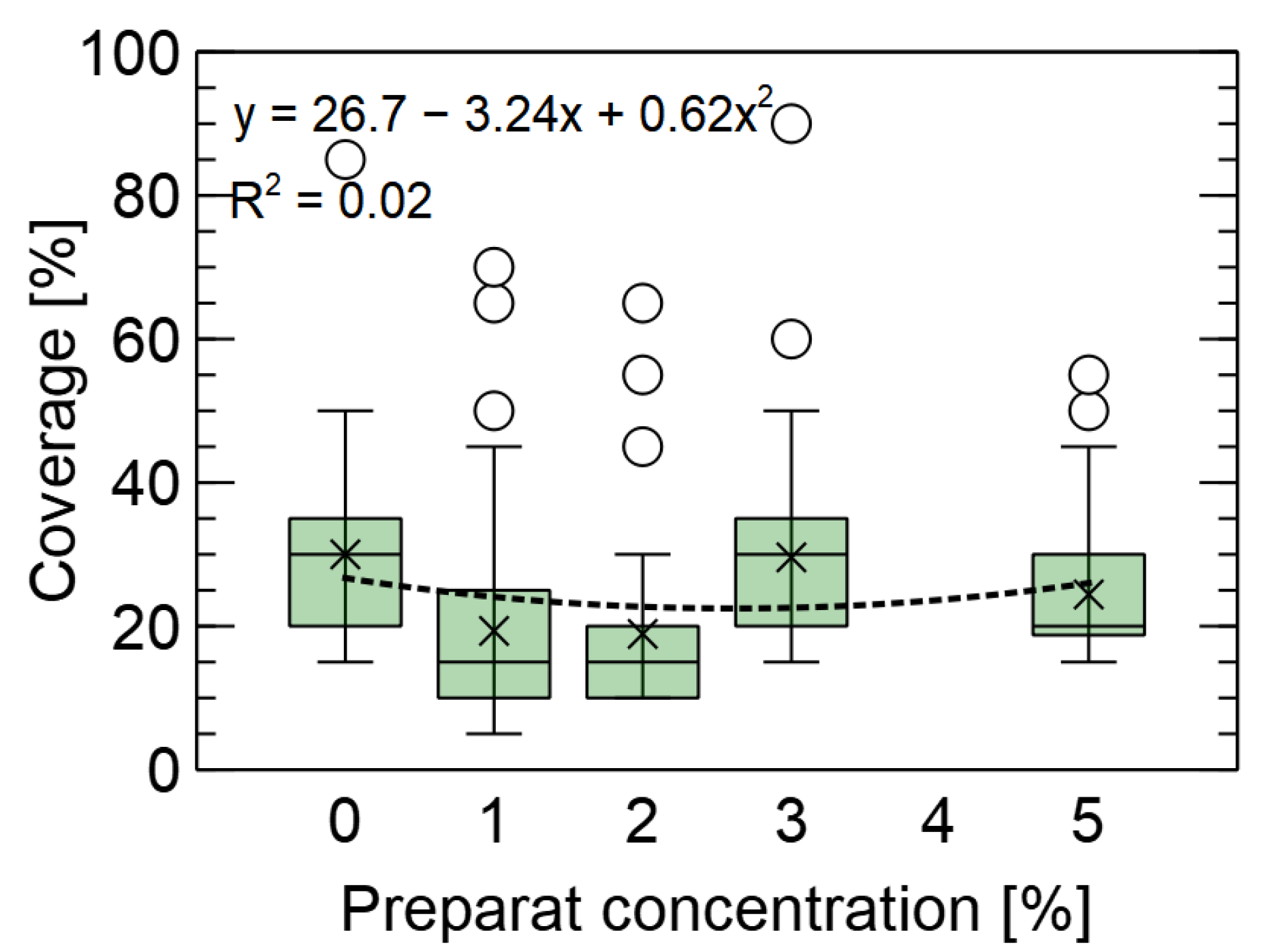
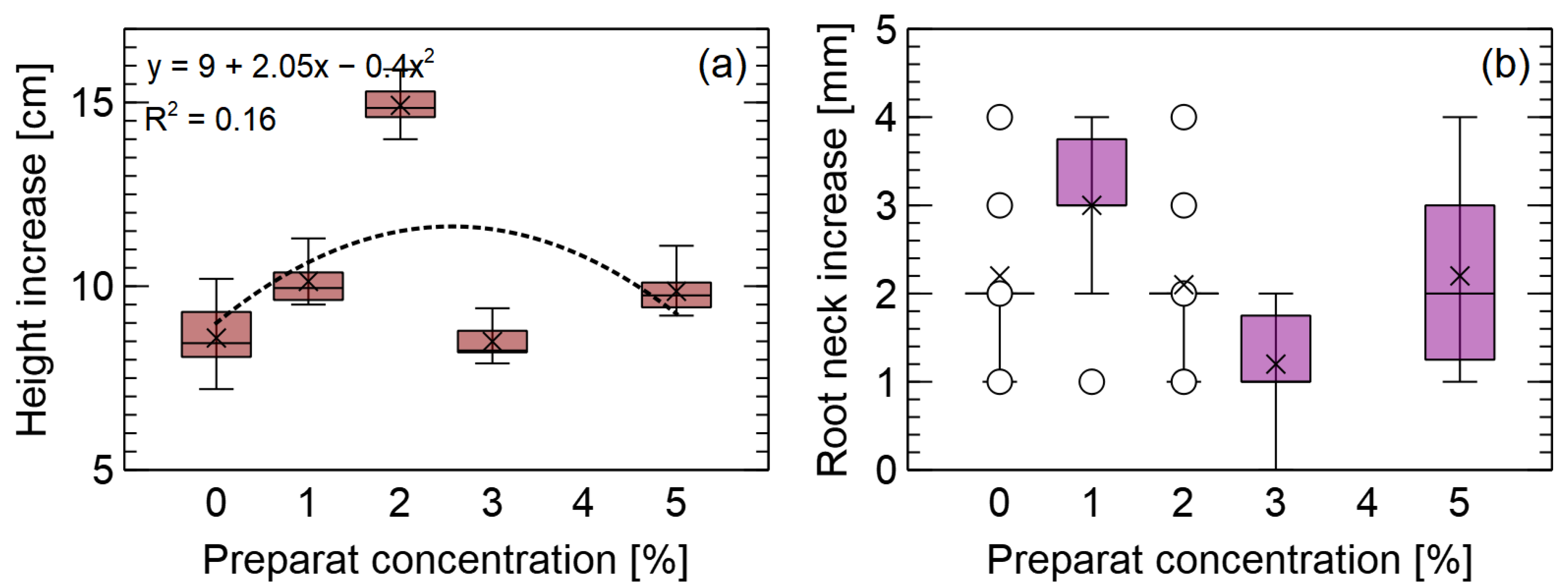
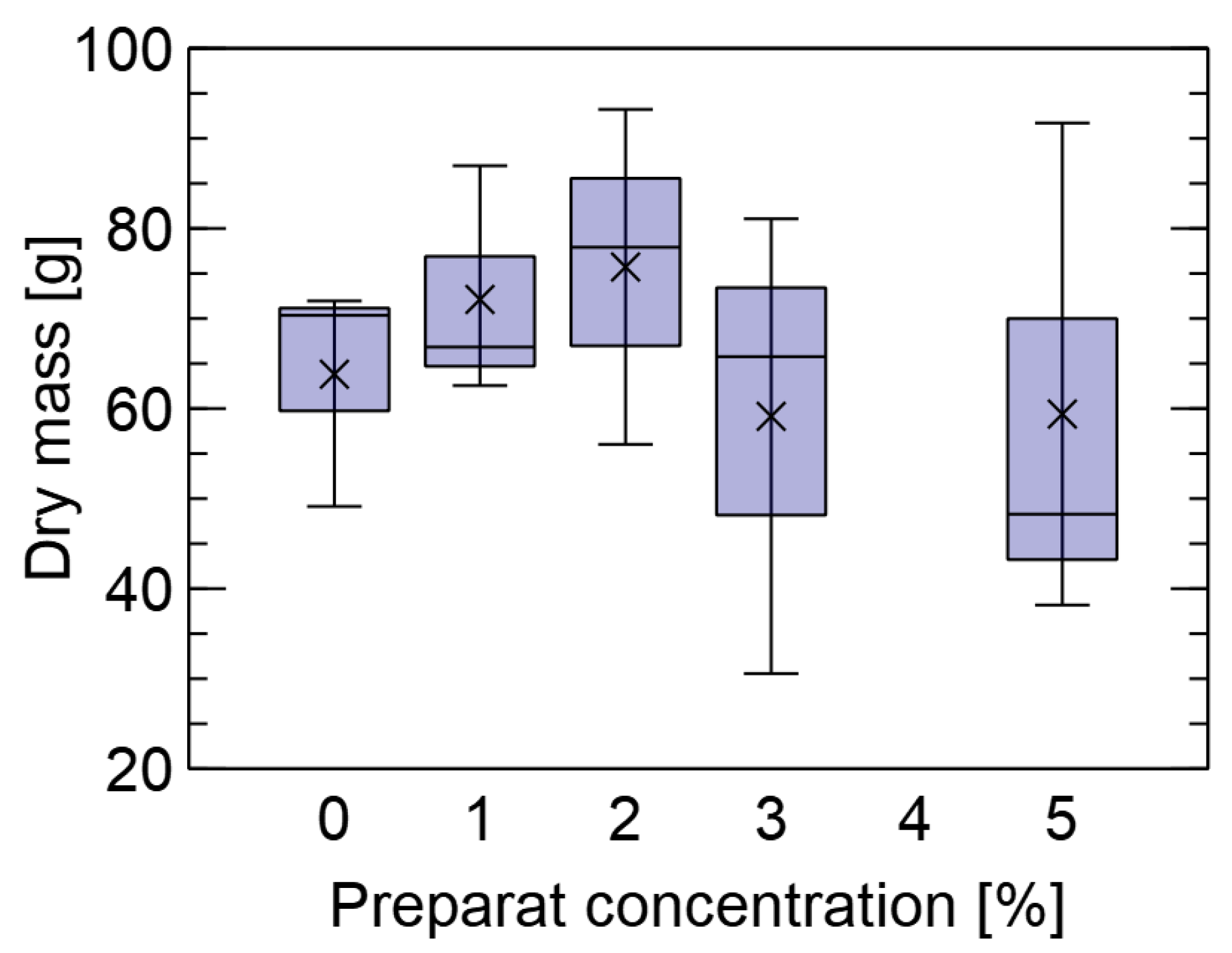

Disclaimer/Publisher’s Note: The statements, opinions and data contained in all publications are solely those of the individual author(s) and contributor(s) and not of MDPI and/or the editor(s). MDPI and/or the editor(s) disclaim responsibility for any injury to people or property resulting from any ideas, methods, instructions or products referred to in the content. |
© 2023 by the authors. Licensee MDPI, Basel, Switzerland. This article is an open access article distributed under the terms and conditions of the Creative Commons Attribution (CC BY) license (https://creativecommons.org/licenses/by/4.0/).
Share and Cite
Oszako, T.; Kowalczyk, K.; Zalewska, W.; Kukina, O.; Nowakowska, J.A.; Rutkiewicz, A.; Bakier, S.; Borowik, P. Feasibility of Using a Silicon Preparation to Promote Growth of Forest Seedlings: Application to Pine (Pinus sylvestris) and Oak (Quercus robur). Forests 2023, 14, 577. https://doi.org/10.3390/f14030577
Oszako T, Kowalczyk K, Zalewska W, Kukina O, Nowakowska JA, Rutkiewicz A, Bakier S, Borowik P. Feasibility of Using a Silicon Preparation to Promote Growth of Forest Seedlings: Application to Pine (Pinus sylvestris) and Oak (Quercus robur). Forests. 2023; 14(3):577. https://doi.org/10.3390/f14030577
Chicago/Turabian StyleOszako, Tomasz, Konrad Kowalczyk, Weronika Zalewska, Olga Kukina, Justyna Anna Nowakowska, Artur Rutkiewicz, Sławomir Bakier, and Piotr Borowik. 2023. "Feasibility of Using a Silicon Preparation to Promote Growth of Forest Seedlings: Application to Pine (Pinus sylvestris) and Oak (Quercus robur)" Forests 14, no. 3: 577. https://doi.org/10.3390/f14030577




